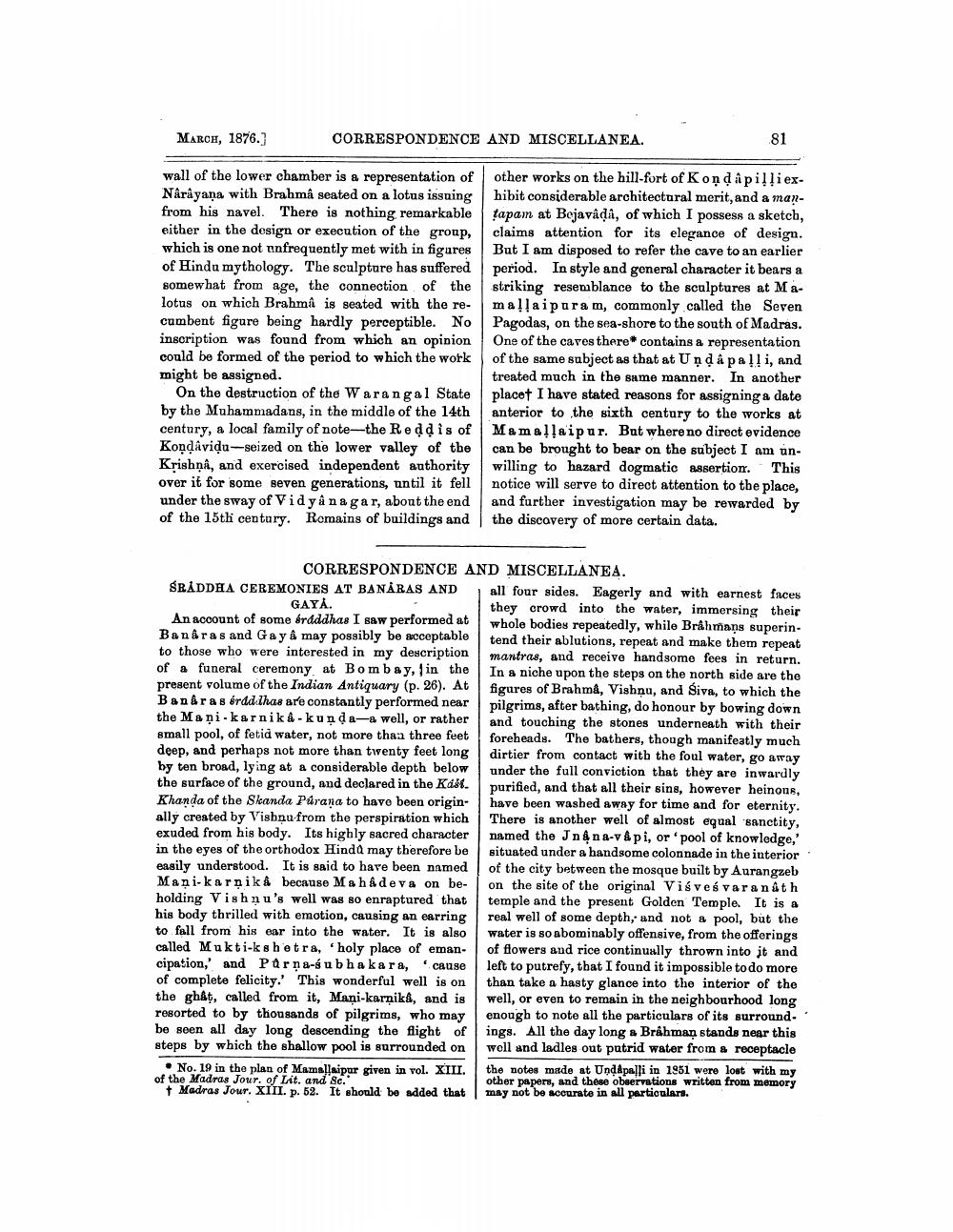________________
MARCH, 1876.]
CORRESPONDENCE AND MISCELLANEA.
wall of the lower chamber is a representation of other works on the hill-fort of KondâpilliexNarayana with Brahmâ seated on a lotus issuing hibit considerable architectural merit, and a manfrom his navel. There is nothing remarkable tapam at Bejavâda, of which I possess a sketch, either in the design or execution of the group, claims attention for its elegance of design. which is one not unfrequently met with in figures But I am disposed to refer the cave to an earlier of Hindu mythology. The sculpture has suffered period. In style and general character it bears a somewhat from age, the connection of the striking resemblance to the sculptures at Malotus on which Brahmi is seated with the re- malla iparam, commonly called the Seven cumbent figure being hardly perceptible. No | Pagodas, on the sea-shore to the south of Madras. inscription was found from which an opinion | One of the caves there* contains a representation could be formed of the period to which the work of the same subject as that at Und á palli, and might be assigned.
treated much in the same manner. In another On the destruction of the Warangal State placet I have stated reasons for assigning a date by the Muhammadans, in the middle of the 14th anterior to the sixth century to the works at century, a local family of note-the Redd is of Mamalla ipur. But where no direct evidence Kondavidu-seized on the lower valley of the can be brought to bear on the subject I am unKrishnâ, and exercised independent authority willing to hazard dogmatic assertion. This over it for some seven generations, until it fell notice will serve to direct attention to the place, under the sway of Vidya nagar, about the end and further investigation may be rewarded by of the 15th century. Remains of buildings and the discovery of more certain data.
CORRESPONDENCE AND MISCELLANEA. GRADDHA CEREMONIES AT BANÅRAS AND all four sides. Eagerly and with earnest faces GAYA.
they crowd into the water, immersing their An account of some braddhas I saw performed at
whole bodies repeatedly, while Brahmans superin. Banaras and Gay â may possibly be acceptable tend their ablutions, repeat and make them repeat to those who were interested in my description mantras, and receive handsome fees in return. of a funeral ceremony at Bombay, in the In a niche upon the steps on the north side are the present volume of the Indian Antiquary (p. 26). At figures of Brahma, Vishnu, and Siva, to which the Banaras érddthas are constantly performed near
pilgrims, after bathing, do honour by bowing down the Maņi-karnik & -kunda-a well, or rather
and touching the stones underneath with their small pool, of fetid water, not more than three feet foreheads. The bathers, though manifeatly much deep, and perhaps not more than twenty feet long dirtier from contact with the foul water, go away by ten broad, lying at a considerable depth below under the full conviction that they are inwardly the surface of the ground, and declared in the Kds. purified, and that all their sins, however heinone. Khanda of the Skanda Púrana to have been origin- have been washed away for time and for eternity. ally created by Vishnu from the perspiration which There is another well of almost equal "sanctity, exuded from his body. Its highly sacred character named the Jnen a-v&pi, or 'pool of knowledge,' in the eyes of the orthodox Hindd may therefore be situated under a handsome colonnade in the interior easily understood. It is said to have been named of the city between the mosque built by Aurangzeb Mani-karnik & because Mahadeva on be- on the site of the original Visves varanath holding Vishnu's well was so enraptured that temple and the present Golden Temple. It is a his body thrilled with emotion, causing an earring real well of some depth, and not a pool, but the to fall from his ear into the water. It is also water is so abominably offensive, from the offerings called Mukti-kshetra, holy place of eman- of flowers and rice continually thrown into it and cipation, and Parna-subhakara, 'cause left to putrefy, that I found it impossible to do more of complete felicity. This wonderful well is on than take a hasty glance into the interior of the the ghất, called from it, Mani-karnika, and is well, or even to remain in the neighbourhood long resorted to by thousands of pilgrims, who may enough to note all the particulars of its surround. be seen all day long descending the flight of ings. All the day long & Brahman stands near this steps by which the shallow pool is surrounded on well and ladles out patrid water from a receptacle
• No. 19 in the plan of Mama!ļaipur given in vol. XIII. the notes made at Undapaļļi in 1951 were lost with my of the Madras Jour. of Lit. and Sc.
other papers, and these observations written from memory t Madras Jour. XIII. p. 52. It should be added that may not be accurate in all particulars.




